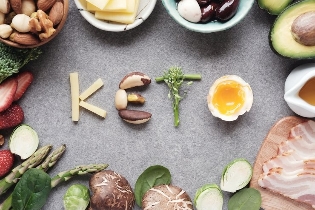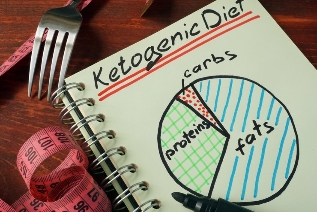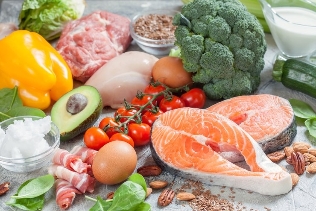
One of the most optimal diets based on a good scientific and medical foundation is ketogenic. Originally developed for the treatment of childhood epilepsy, this diet is low in carbohydrates, high in fat, and low in protein. Such a diet leads to ketosis, in which the body's own fats are burned.
The essence of ketosis
In a diet that limits carbohydrate intake, external resources for glucose production are excluded. The brain is forced to command the body to compensate for its absence, and its own fats act as a compensatory resource. They are converted into fatty acids and ketone bodies. It is ketones that replace the missing glucose. An increase in their concentration in the blood is called ketosis. In fact, it is the process of the body's survival and the saving of the brain in the event of insufficient external intake of carbohydrates and fats.
The keto diet for weight loss
Originally developed to prevent epileptic seizures, the keto diet can be used as an effective weight loss system. Its use causes the liver to produce ketones and insulin levels drop sharply. Insulin is responsible for organizing fat stores in the body. A drop in the insulin concentration leads to weight loss: fat is not stored, but used by the body to generate energy.
Besides the main advantage of ketosis, this diet has bonus properties:
- Hunger decreases;
- the body contains a constant source of energy;
- sticking to a keto diet can be quite lengthy;
- is ideal for sports that require a lot of stamina, as it saves glycogen stores.
The principle of low-carbohydrate, high-fat diet ("low-carbohydrate, high-fat"), first implemented by dietitians in Sweden, has been used to confirm the correctness of the "fatty" diet idea.

The LCHF diets that were introduced in the early 2000s have already proven their relevance and harmlessness for the body.
BUCH works very similarly: The abbreviation stands for protein-carbohydrate change in food. Because of this variety, the body resorts to emergency burning of stored glycogen and then its own fats.
In the classic anti-epileptic keto diet, the ratio of fat to protein carbohydrates is 4: 1. The keto version for weight loss is geared towards a higher protein content and a lower carbohydrate content.
Avoiding foods high in carbohydrates is a practical step. This:
- sweet fruits and vegetables;
- baked goods;
- noodles;
- sugar;
- starchy and legume vegetables.
A large number of foods saturated with fat are included in the diet: cheese, fatty cottage cheese and butter. Since MCFAs are preferred for the keto diet, one option is a diet that includes coconut oil. In this product, the concentration of MCT (oil consisting of medium-chain elements with a length of 6–12 atoms) is maximum (15%).
20-30 grams of carbohydrates are sufficient for a daily keto diet. This means net weight, that is, net weight.
Calculating NET carbohydrates is simple: subtract fiber from total carbohydrate intake.
There are no significant protein restrictions. The intake should be within 25% of all food consumed.
There are three types of the keto diet:
- Standard. This option involves an almost complete rejection of carbohydrates for the duration.
- goal. Allows the intake of small amounts of carbohydrates to restore glycogen after a serious exercise or physical activity.
- loop. Assumes the consumption of carbohydrates as needed in direct relation to the degree of exhaustion of the body.
Diet phases
It will take a week for the body to get used to such a diet. This process takes place in three steps. The first two phases usually last two days and include:
- twelve-hour stage of glycogen production from carbohydrates in the food consumed;
- the use of glycogen in the body, which is stored in liver tissue and muscles.
This is followed by a phase of three to five days in which the body tries to get the missing energy from the proteins in the daily diet and from the body's muscles. This phase is more difficult than the previous ones, both mentally and physically.

The next step is the end of the adaptation of the metabolism to an artificially generated extreme regime, the burning of your own triglyceride supply and the production of ketone bodies. With the onset of ketosis, the breakdown of body proteins slows down.
Under these conditions, the weight loss is between 0. 5 and 2. 5 kg per week.
Planning for the first week includes consuming 50/50 protein and fat. In order to maintain muscle mass and not subject body proteins to degradation, at least 4 g of protein per 1 kg of body weight should be consumed with food.
In the second week this ratio is assumed:
- fats - 65-75%;
- proteins - 25-30%;
- carbohydrates - 5%.
Benefits of the keto diet
While weight loss is comparable, the keto diet has a number of beneficial differences over low-calorie diets.
- Reduces the insulin level more clearly.
- Reduces the level of sugar in the body and is an excellent prevention of diabetes and one of the treatment methods.
- Promotes higher brain performance by helping to avoid blood sugar spikes and by increasing the amount of useful fatty acids in this regard.
- Weight loss during the keto diet leads to blood pressure stabilization.
- The condition of the skin improves, which is especially important for women.
- There is a classic version of the diet that effectively counteracts the development of epilepsy.
- Ideal for endurance sports as it saves insulin storage.
Contraindications and side effects
For most healthy people, a ketogenic diet is safe. At the same time, a preliminary consultation with a nutritionist is required in the presence of a number of diseases.
Keto restrictions can be caused by:
- taking antidiabetic drugs;
- high blood pressure;
- the need to breastfeed;
- the presence of liver disease, kidney disease or pathologies of the cardiovascular system.
Some of the unusual side effects of the keto diet include:
- muscle cramps;
- constipation;
- decreases physical stamina in those who use keto for the first time;
- hair loss;
- Deficiency of breast milk or loss of quality during breastfeeding;
- worsening symptoms of gallstone disease;
- dyspepsia;
- the appearance of itchy skin;
- decreased mental alertness and ability to concentrate for longer;
- Diet imbalance.
The keto diet menu
In order to get into a ketosis state quickly, the carbohydrate intake should be limited to a daily requirement of 15 grams. Diet involves obtaining these nutrients mainly from nuts, vegetables and dairy products.
So,What you can eat on the keto diet, food list:
- Meat, fish and eggs in any form - are the main suppliers of protein and polyunsaturated fatty acids;
- seafood - due to their saturation with microelements;
- fiber-rich leafy vegetables;
- ground vegetables;
- Dairy products - contain a lot of calcium, vitamins and minerals;
- berries with a low glycemic index - blackberries, raspberries;
- low-carbohydrate sweeteners;
- coconut oil and other saturated fats;
- sour apples, cherries, pomegranates.
How to replace bread
The question is what to eat instead of bread. This can be a toasted thin omelette made from eggs. You can also buy almond and coconut flour and use it to make your "bread". Fried cheese or regular cheese also form the basis of a sandwich with vegetables, fish or meat.
Distribution of food throughout the day
- Breakfast. The approximate calorie content is in the range of 550-600 kcal. Cheese, vegetables, scrambled eggs or a protein shake. You shouldn't consume more than 15 g of carbohydrates during breakfast.
- Lunch in terms of carbohydrates is limited to the same 15 g, but the calorie content is lower: 350–400 kcal. Lunch includes meat or meatball soup with no noodles. Another option is rice and chicken breast.
- Dinner is possible with meat or fish with green vegetables. Calorie content - 300 kcal.
- Snacks should not bring more than 5 g of carbohydrates into the body. Includes cheese, fish, nuts, cottage cheese.
Rules for entering ketosis
The following steps can help you to enter your ketosis optimally:
- Rejection of short-term frequent snacks, which leads to an increase in insulin;
- dosed performance of physical exercises;
- a menu with a priority on fat as the main source of energy in a ketogenic diet;
- Reducing protein intake to 1. 5 g per 1 kg of body weight;
- Consumption of net carbohydrates in doses of not more than 20 g per day;
- significant fluid intake - up to four liters per day. In addition to water, you can drink green tea and coffee without sugar.
- competent planning of energy consumption for the week.
Signs of ketosis are:
- natural loss of appetite;
- burst of energy and improved mood;
- the appearance of the odor of acetone from the mouth and from the body;
- Evidence of the presence of ketones in the urine.
Testimonials from doctors on the disadvantages of the keto diet
The keto diet is categorically contraindicated in fermentopathies (diseases with a deficiency in enzymes that break down fats and proteins), in chronic adrenal insufficiency, in chronic liver and kidney insufficiency. Such protein and fat load can simply be unbearable for people with similar pathologies.
Diseases of the liver, pancreas, and gallbladder can also get worse or occur during a keto diet.
A keto diet is also not suitable for people with high cholesterol levels, as it leads to an increased formation of atherosclerotic plaques and, as a result, to a worsening of the vascular condition. This method of losing weight is also not suitable for some endocrinological diseases (for example, hypothyroidism).
But even healthy people need to be extremely careful when consuming this type of food. Due to the change in diet to protein and fat, the microbial landscape of the intestine can change. An excess of protein and a lack of vegetables and fruits can cause unwanted microflora to grow in the intestines, causing gas, constipation, and poor digestion. Of course, due to the restricted diet of vegetables and fruits, one can fear hypovitaminosis and a lack of certain trace elements, which in turn can lead to a decrease in immunity.
There is only one conclusion: before deciding on a keto diet, you need to consult a competent specialist, taking into account anamnestic data, to clarify whether it is safe for you. And if a decision is made in favor of adhering to a diet, then current monitoring of the patient's condition will continue to be necessary in order to prescribe vitamins, trace elements and probiotics, if necessary.
Summary:
- The low carbohydrate regimen is noteworthy because it is scientifically based and empirically proven to be effective.
- Compared to low-calorie protein diets, the results of such a system are more humane in terms of the body's physical and mental resources.
- In the course of a diet, it is not difficult to calculate the table layout for each day and buy the quality products you need.
- Such a diet practically does not restrict the usual way of life.
- Suitable for both men who do hard physical work and are used to eating a lot of meat, as well as women who solve their cosmetic problems.
- Additional results of the diet are the prevention of pressure surges, the normalization of the cholesterol level and an improved brain function.


















